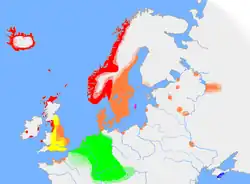古哥得兰语
古哥得兰语或古哥特兰语[2]是一种北日耳曼语支语言,分布在波罗的海上的哥得兰岛。它与古西诺斯语、古东诺斯语均有较大差异,被认为自成一支。现代哥得兰语仍分布在哥得兰岛的某些部分,但比起古哥得兰语更像现代瑞典语,与法罗岛相邻。
| 古哥得兰语 | |
|---|---|
| 区域 | 哥得兰岛 |
| 語系 | |
| 語言代碼 | |
| ISO 639-3 | 无(mis) |
| Glottolog | gutn1238[1] |
| IETF | non-u-sd-sei |
古诺斯语双元音au(如auga“目”)保留在古哥得兰语和古西诺斯语中,而古东诺斯语中除外围次要方言外,单化为ǿ,也即ø的延长。bain“骨”中的ai也在古哥得兰语中得到保留,而古西诺斯语变为ei,即bein,古东诺斯语变为é,即bén。
| 原始日耳曼语 | 古哥得兰语 | 古西诺斯语 | 古东诺斯语 |
|---|---|---|---|
| *augô(目) | auga | auga | auga>ǿga |
| bain | bein}} | bæin>bén | |
| *hauzijaną(听) | hoyra | heyra | høyra>hǿra |
古哥得兰语绝大多数语料都发现于13世纪的哥得萨迦。
语例
原文:
标准古哥得兰语转写:
应用古诺斯正字法:
译为冰岛语:
译为英语:
This Thielvar had a son called Hafthi. And Hafthi's wife was called Hvitstjarna ("White star"). Those two were the first to settle on Gotland. When they slept on the island for the first night, she dreamed that three snakes lay in her lap, and she thought they were sliding off her lap. She told this to Hafthi. He interpreted her dream and said: "Everything is bound with bangles, this island will be inhabited, and you will bear three sons." Although, they were not yet born, he named them Guti, who would own the island, Graip and Gunfiaun. The sons divided the island into three regions, and Graip, who was the eldest, took the north, Guti the middle, and Gunfjaun, who was the youngest, took the southern third. After a long time, their descendants became so numerous that the island could not support all of them. They drew lots and every third islander had to leave. They could keep everything they owned but the land.
译为汉语:
这个Thielvar有一个儿子叫Hafthi。Hafthi的妻子被称为Hvitstjarna(“白星”)。他们两个是首先在哥特兰定居的人。他们睡在一起的第一晚,她梦见三条蛇躺在她的腿上,她以为它们正从她腿上滑下来。她把这件事告诉了Hafthi。他解读道:“一切都被束缚住了,这个岛将有人居住,我们将有三个儿子。”他将尚未出生的他们命名为Guti,将拥有该岛;还有Graip和Gunfiaun。儿子们三分哥得兰,最年长的Graip占据北部,Guti居中,最小的Gunfiaun占据南部。久而久之,他们的子孙繁多,整座岛都养活不了他们。他们抽签,每三个岛民都必须有一个离开。他们可以保留他们拥有的一切,但土地除外。
参考
- Hammarström, Harald; Forkel, Robert; Haspelmath, Martin; Bank, Sebastian (编). . . Jena: Max Planck Institute for the Science of Human History. 2016.
- Swedish于《民族语》的链接(第18版,2015年)
